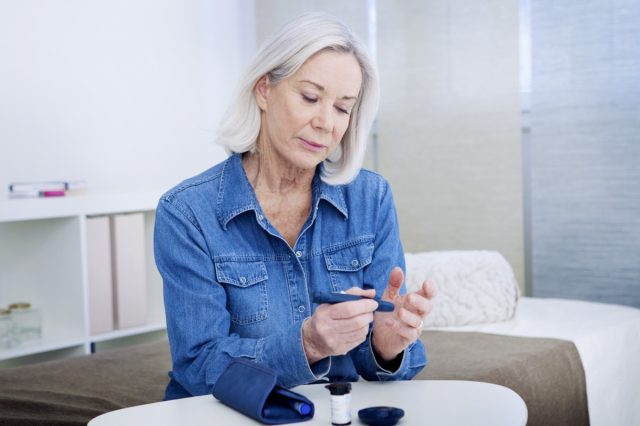Managing blood sugar is crucial for people with type 1 and type 2 diabetes, especially those who take insulin. “Studies have recently shown that overall good control of blood sugar in diabetes does correlate with decreased incidence of diabetic complications,” says James Norman, MD, FACS, FACE. “So… yes, it is important to control glucose levels as best as possible. In people with type 1 diabetes who are on insulin and in some people with type 2 diabetes, efforts to have control too tight may result in too many episodes of hypoglycemia (low blood sugar). Therefore, the goal is to balance trying to have control as near normal as possible while trying to avoid hypoglycemic episodes.” Here are five things the CDC wants you to know about managing blood sugar. Read on to find out more—and to ensure your health and the health of others, don’t miss Already Had COVID? These Symptoms May “Never Go Away”.


High blood sugar, or hyperglycemia, is commonly associated with type 2 diabetes and dangerous if left untreated. “Early signs of high blood sugar, or hyperglycemia, may serve as a warning even before you test your glucose level,” says Amy Hess-Fischl, MS, RD, LDN, BC-ADM, CDCES. “Typical high sugar symptoms may include increased thirst and/or hunger, frequent urination, sugar in your urine, headache, blurred vision, [and] fatigue.”


The CDC warns that diabetic ketoacidosis is a condition where ketones are produced too fast, and can lead to coma or even death. “If you have type 1 diabetes, it is important to recognize and treat hyperglycemia because if left untreated it can lead to a dangerous condition called ketoacidosis,” says Hess-Fischl. “This happens because without glucose, the body’s cells must use ketones (toxic acids) as a source of energy. Ketoacidosis develops when ketones build up in the blood. It can become serious and lead to diabetic coma or even death. According to the American Diabetes Association, ketoacidosis affects people with type 1 diabetes, but it rarely affects people with type 2 diabetes. Many symptoms of ketoacidosis are similar to hyperglycemia. The hallmarks of ketoacidosis are high levels of ketones in the urine, shortness of breath, fruit-smelling breath, [and] dry mouth. Additionally, stomach pain, nausea, vomiting, and confusion may accompany ketoacidosis. Immediate medical attention is highly recommended if you have any of these symptoms.”


Low blood sugar, or hypoglycemia, can be caused by taking too much insulin, drinking excessive amounts of alcohol, or missing meals. Symptoms include shaking, sweatiness, hunger, and nervousness/irritability. “If a person is acting a bit goofy or boisterous (often described as seeming ‘drunk’ while perfectly sober) but they deny symptoms of hypoglycemia, then ask them to check their blood glucose level with a blood glucose monitor,” advises diabetes specialist David Klonoff, MD. “The result might be surprisingly low. In that case, the person can be rescued with oral sugar before their condition worsens to where they are at risk of brain damage associated with going into a hypoglycemic coma.”
“Management means that fine line diabetes patients walk between normal blood sugar and abnormal blood sugar,” says Dr. Elena Christofides. “Simple avoidance of hypoglycemic episodes isn’t the correct way to think about it. The most important thing that people need to appreciate is that avoidance of hypoglycemia by maintaining their blood sugar artificially high is not saving them, as high blood sugar presents its own risks.”


“A blood sugar target is the range you try to reach as much as possible,” says the CDC. “These are typical targets—before a meal: 80 to 130 mg/dL. Two hours after the start of a meal: Less than 180 mg/dL. Your blood sugar targets may be different depending on your age, any additional health problems you have, and other factors. Be sure to talk to your health care team about which targets are best for you.”


The best way to keep track of your blood sugar is by regular testing, experts say. “Monitoring your blood sugar is the best way to find out how well your diabetes is being controlled, and gives you information on how to manage your diabetes on a daily basis. If your blood sugar is too low or too high, your healthcare provider might want to adjust your diet, exercise schedule, or the amount of medicine you are taking,” says Cleveland Clinic. And to protect your life and the lives of others, don’t visit any of these 35 Places You’re Most Likely to Catch COVID.
Ferozan Mast
from WordPress https://ift.tt/fFN6LPY
via IFTTT










No comments:
Post a Comment